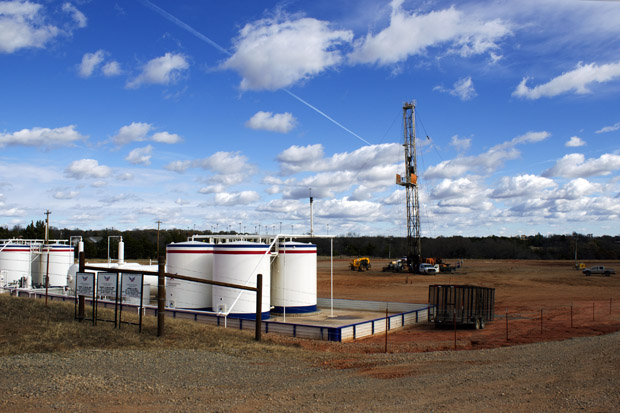
An American Energy Woodford well near Perkins, Okla.
Joe Wertz / StateImpact Oklahoma


An American Energy Woodford well near Perkins, Okla.
Joe Wertz / StateImpact Oklahoma

Joe Wertz / StateImpact Oklahoma
An American Energy Woodford well near Perkins, Okla.
As earthquakes continue to surge in Oklahoma and seismologists warn of more frequent and more damaging shaking, the state’s oil and gas regulator is issuing new orders to companies operating wells in seismically active regions of the state.
The Oklahoma Corporation Commission’s new requirements, known as directives, were mailed March 18 to 92 people or companies operating 347 Arbuckle formation disposal wells in quake-prone regions of the state.
The directives expand the definition of “areas of interest” — a term the agency uses to describe locations of concentrated seismic activity — and require operators to prove to the commission that their wells aren’t in contact with granite basement rock. Fluid injection into basement rock has been identified by researchers as a major risk factor for triggering earthquakes.
“This is a way of quickly getting our hands around the issue, particularly in those areas that have seen huge increases in seismicity,” says commission spokesman Matt Skinner.
Commission rules that took effect in September 2014 require operators of Arbuckle formation disposal wells to provide the agency with more detailed and frequent volume and pressure measurements. The Arbuckle is a deep rock formation that underlies most of Oklahoma and is known for its ability to absorb and hold fluid — a characteristic that has made it a popular target for wastewater disposal.
More recently, the commission has revised its permitting process to scrutinize disposal wells and has employed a “traffic light” system to manage wells in quake-prone areas which, under the previous system, included wells located within 6 miles of a magnitude-4.0 or greater earthquake.
The new orders were written to take into account “swarms” of earthquakes, and define areas of interest as any region within 6 miles of locations containing at least two earthquakes within a quarter-mile of each other, with at least one of the quakes registering a 3.0 or greater magnitude.
The new directives issued this month are more strident than previous quake-related commission actions and put on oil companies the onus of proving their wells aren’t capable of injecting fluid into basement rock. To do this, operators are given 30 days to supply the commission with well logs or gamma ray tests to verify a well’s depth. Many operators have already performed such tests, Skinner says. Operators who haven’t will likely have to shut down wells before the tests are performed.
Under the new directives, operators found to be injecting into basement rock will be required to “plug-back,” or fill in wells to a shallower depth to prevent waste fluid from contacting the basement rock.
“We figure the average costs per well are about $100,000,” Skinner says.
Operators that don’t meet the reporting or plug-back criteria by April 18 will have their disposal volumes cut by 50 percent, according to the letter mailed by the commission.
In a prepared statement, Kim Hatfield, regulatory committee chairman with the Oklahoma Independent Petroleum Association, said the state oil industry supports the continued study of Oklahoma’s earthquake activity “and its possible relationship to the oil and natural gas industry.”
“We are confident that the cooperation between public and private entities will offer a rational and reasonable response to seismic activity concerns,” he said. “The most recent action by the Corporation Commission continues that longstanding commitment to Oklahoma and is a reasonable effort to develop greater understanding of Oklahoma’s seismic events.”
Gov. Mary Fallin on Wednesday directed Secretary of Energy and Environment Michael Teague to transfer $50,000 from his office to the Corporation Commission for the hiring of more employees to help track the disposal wells, and in a statement says she agrees with the commission’s action.
“The Oklahoma Corporation Commission today took appropriate and necessary action to ensure there are no disposal wells below a certain depth in an area we believe is vulnerable to seismic activity,” Fallin says.
More earthquakes were recorded in Oklahoma than California last year, and the seismic activity is showing some signs of escalation: 584 magnitude-3.0 or greater earthquakes were recorded in 2014, compared to 205 recorded so far in 2015, data from the Oklahoma Geological Survey show.
In May 2014, seismologists at the OGS and U.S. Geological Survey warned of a “dramatic” increase in the risk of Oklahoma experiencing a larger, more-damaging earthquake, and research published earlier this month suggests “reawakened” faults responsible for thousands of earthquakes throughout the state are capable of producing larger earthquakes than previously thought.
Fluid-triggered earthquakes, so-called “induced seismicity,” have been observed since the 1960s. Scores of peer-reviewed scientific papers have linked Oklahoma earthquakes to fluid injection from disposal wells, a type of well the oil and gas industry pumps full of waste fluid — a byproduct of drilling and well-completion techniques like hydraulic fracturing, known as “fracking.”
Oklahoma’s largest earthquake recorded with modern instruments — a 5.7-magnitude temblor that struck near Prague in November 2011, injuring people and damaging buildings — is among the earthquakes researchers say were likely triggered by disposal wells.
For decades, injecting drilling waste fluid — which is often highly salty and full of toxic chemicals — into deep wells has been the preferred method of disposal because it traps the fluid under layers of rock, reducing the likelihood it will contaminate sources of water.
Seismologists have linked disposal wells to quakes in other states, including Texas, Arkansas, Colorado and Ohio.
“Statistically it’s quite clear that the more earthquakes you have, with an increase in magnitude, the greater your chance for a major quake,” the commission’s Skinner says. “We don’t look at this as something we have time for.”